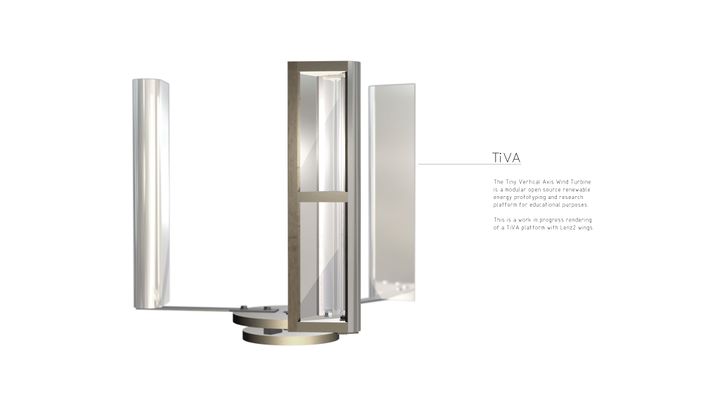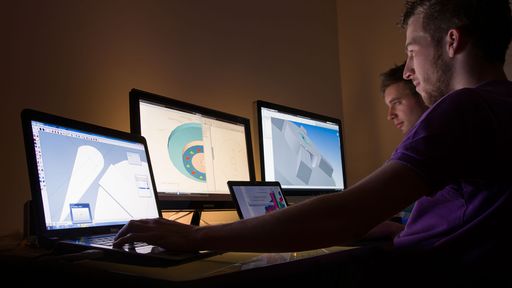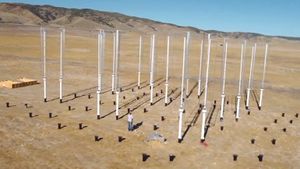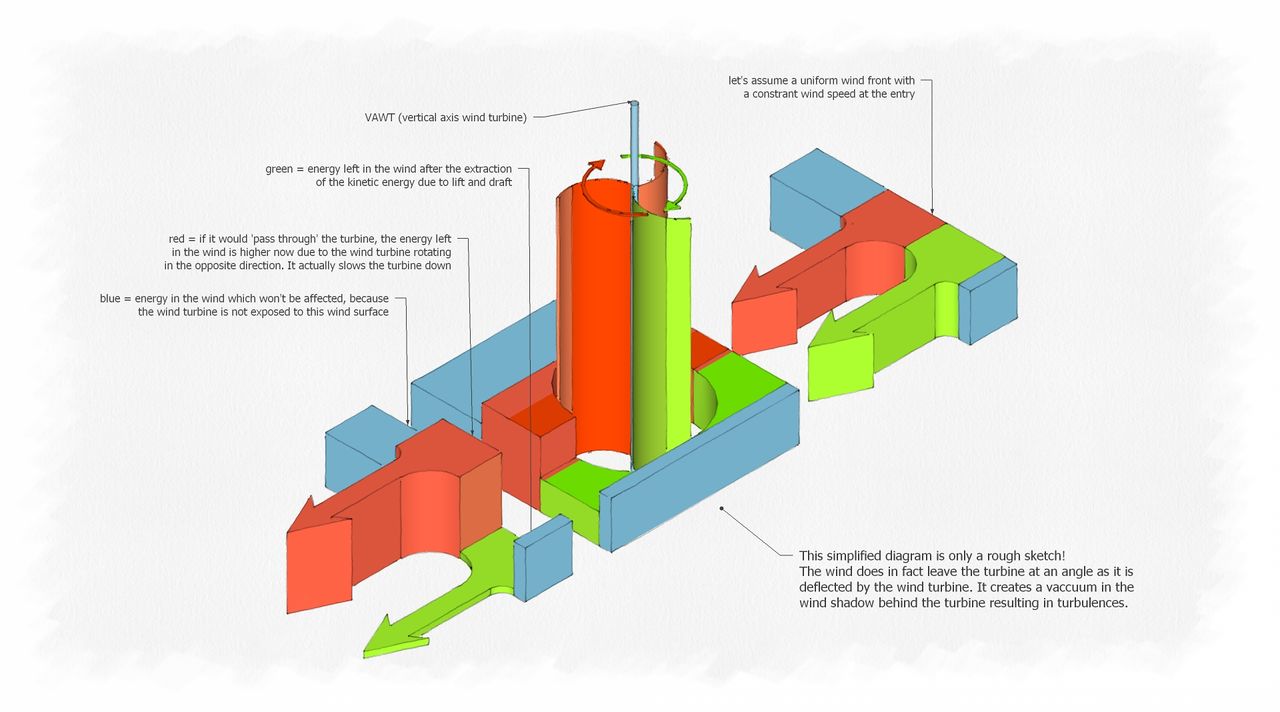Wind Turbine/en
Status
The wind turbine is in the research phase of product development, we are focusing on the TiVA-System right now.
Introduction
We are developing an open source wind turbine with an agile open collaboration.
TiVA and wind turbine specifications started with a joint development venture between etemu.com and Apollo-NG. All information is released open source and for free, for a better world and for the fun of open collaboration. (CC BY-SA-NC)
TiVA
Research and development is currently concentrated onto TiVA, a tiny wind turbine prototyping platform. With this very small turbine, we can easily change parts, try out new ideas and increase the quality of the design on a small scale in a fast and inexpensive way. Please have a look at the TiVA page for further information.
Team
If you want to participate, just get in touch via our Forum or just hit Shure an e-mail. :)
- Alex Shure – lead designer, research and development, modeling, prototyping
- Mario - 3D modelling (Autodesk Inventor, Maxon Cinema 4D)
- Achmed Touni - 3D modelling (FreeCAD, Blender3D), simulation (OpenFOAM, Ansys)
- Nikolay Georgiev - communication and organization
- Benjamin 'champ' - Wilssen, controller electronics and software
Open Tasks
You can help us with any improvement on the project or with the following specific tasks:
Development of Wilssen
The Wireless / Wind Logging System for Sourcing ENergy - Controller is monitoring and controlling all parameters. Wilssen is the brain of the wind turbines (+TiVAs!) and checks all the voltages at any time the wind turbine is generating power.
Scope:
- Platform AVR (Arduino) or MSP430 Value Line or another low-priced alternative (chipKIT?)
- Language C / Assembler, source code will be licensed under CC-BY-SA in our git repository.
Hardware:
- Development environment either Arduino (32kb Flash, 8bit MCU) or Texas Instruments MSP430 Value Line LaunchPad (16bit MCU). Wilssen consists of one or more microcontrollers and digital and analog electronic components, which can be populated if needed.
- Energy monitoring with Shunt+OpAmp+ADC or ICs + ADC/SPI of every alternator phase, battery
- Voltage monitoring of all phases (True RMS, option for galvanic isolation)
- NRF24L01+ 2.4Ghz radio communication (mesh networking would be awesome :) )
- Option for waveform sampling, softscope (e.g. output the waveform at a specified sample interval in 10bit via serial over the wireless link)
- Logging on MicroSD
- RGB LED PWM output (3 channels, R+G+B)
- Charging logic for 4 NiMH cells / 1 lead acid gel battery (delta-peak charging)
Others
- Design a mold for casting the alternator's stator
- 3D Models and Simulation (Achmed and Mario are working on it)
- Calculations for the forces at the bearing points and the mounting point
- LED drivers, controllable constant current sources for the high power LEDs
- (many more soon to come)
We still need the following materials for our first prototypes:
- Round sheets of metal for the alternators
- Plywood (Multiplex)
- Tools for the lathe, boring bar, inserts..
- Aluminium sheets for the wings
- Polyester or epoxy resin and hardener + filler
- Paint which can be sprayed, should be a sealing one for outdoors
- Cases for the electronics, IP66<
- Neodymium magnets, preferably 15x5mm<
- Enameled copper wire aka. magnet wire, with a diameter of 0.4 - 1.0mm
- Electric planer
- Aluminium or stainless steel tubes, e.g. 12x8mm for TiVA
Please get in touch with Alex Shure if you want to donate any material or machine which could come in handy for us.
Roadmap / Log
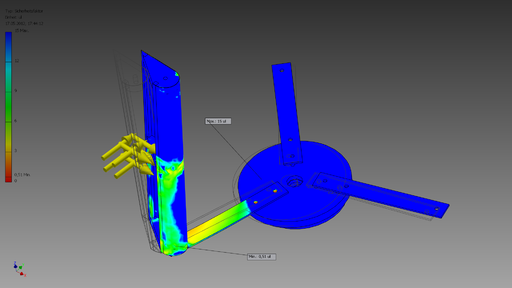
- 20120211 Alex Shure Start of "Open Agile SCRUM GVCS machine development" mailing list, Nikolay Georgiev sent an E-Mail to some OSE:E members - We begin to discuss the OSE:E project of constructing a wind turbine
- 20120222 Alex Shure First online meeting on the OSE:E project "develop a wind turbine" in mumble
- 20120311 Alex Shure I had a 6 hour meeting with a German wind turbine technician who works in QS where we discussed various aspects, advantages and disadvantages of horizontal and vertical axis wind turbines.
- 20120324 Alex Shure Had an online conference in mumble and spoke with Chrono, founder of the Apollo-NG[1] project. Chrono has experience in electronics, especially in integrated low power switching power supplies and mobile energy supplies. He is transforming a van into a mobile hackerspace, powered by renewable energy, totally off the grid.
- 20120325 Alex Shure Phone conference with Detlef Schmitz from the solar car team Heliodet; Detlef offered to build one small wind turbine prototype. He has contacts also with engineers and technicians form the solar car project, especially students from the FH/uni in Bochum.
- 20120326 Alex Shure Added the EVA wind turbine design. We could develop a VAWT which can be optionally equipped with the EVAwt features. The biggest disadvantage is the design issue with the top cover plate: with the EVAwt design, I can't think of an easy way to span the cables from the top for now.
- 20120327 Alex Shure chrono added a pad on Apollo for collaboration
- 20120328 Alex Shure Calculations
- 20120329 Alex Shure contacted Bernd from http://www.daswindrad.de
- 20120330 Alex Shure Added the TiVA page to the wiki and further designed the concept in the etherpad..
- 20120331 Alex Shure chrono moved the content from the pad at Apollo-NG into the dokuwiki at Apollo-NG. I split the TiVA parts and copied them to a wiki page here at OSE
- 20120404 Alex Shure Researched about copper losses in the enameled copper wire windings, let's use 0.45 - 1 mm wire.
- 20120405 Alex Shure I updated the TiVA wiki entry at OSE with a full BOM for a very first prototype, including sheet material for the negative form, painting and so on. Also got Mario on board, who has experience in 3D modeling.
- 20120406 Alex Shure Meeting with Mario, 3D modelling session in Autodesk Inventor.
- 20120407 Alex Shure Met M. Klein, CEO of Wezek GmbH (engineering, automation) and spoke about waterproof cases for the electronics.
- 20120408 Alex Shure Specification for TiVA's alternator outlined. Diameter reduced to less than 200 mm, 1 phase alternator design is preferred due to less costs and the low power demand.
- 20120409 Alex Shure Finished the calculations of TiVA's alternator. 16 round magnets, 16 coil segments, switchable from 8s1p up to 1s8p, calculated efficiency after rectification is above 90% for low loads.
- 20120410 Alex Shure We should stick to symmetric wing profiles if we go for a Darrieus style lift rotor, because those would be the easiest to fabricate. Researching on some NACA profiles now. Wings of the V-Rotor should incorporate a metal strip sandwiched between the two halves of the wing for the easiest and most rigid wing fixation method.
- 20120412 Alex Shure Fabricated three wings for TiVA out of solid wood (spruce)
- 20120413 Alex Shure Full day working session in the shop for TiVA, made a hub, cut plywood, laminated the base, machined bearing seats on the lathe ...
- 20120414 Alex Shure Glued the cut plywood together, trimmed the edges, made another pass on the lathe after the lamination, to make sure everything is perfectly balanced.
- 20120415 Alex Shure Press-fit the bearings into the hub, tested the starting torque of the assembled hub with the bearings in place: not measurable with a 0.1 N scale -> good! Bought a stand air ventilator for testing purposes.
- 20120416 Alex Shure Ordered parts for the electronics + mechanics: Bearings (DIN 6003), Schottky diodes, M6 - M12 V2A stainless steel bolts and nuts, ...
- 20120417 Alex Shure Bought 5 kg of 0,45 mm diameter enameled copper wire (aka. magnet wire) for about 100,00 EUR. Does anybody have a cheap source for copper wire and magnets?
- 20120422 Alex Shure Tested NACA0018 profiles at various angles: NACA0018 profiles aren't self starting at low angles. Aiming for a Lenz2 profile now.
- 20120426 Alex Shure Designed the alternator rotor assembly, sketched the model in SketchUp.
- 20120429 Alex Shure Ordered passive and active electronic parts.
- 20120507 Alex Shure Rotor assembly just got reconstructed: one less part which is turned on the lathe + implemented the alternator stacking feature.
- 20120508 Alex Shure Achmed is working on a FreeCAD model and will then make a mesh for OpenFOAM, an open source CFD software package.
- 20120510 Alex Shure Meeting with Mario, instructed him about the 3D model. We also agreed on leaving the NACA lift-only profiles for TiVA behind, as the Reynolds number is just too high for these small dimensions.
- 20120512 Alex Shure 3D modelling session with Mario, finished TiVA's rotor base and began with the Lenz2 lift/drag hybrid wing profile.
- Nov 2012 Alex Shure I stopped using the wiki as a crude archive and did not protocol everything which happened since May '12. A severe amount of time was put into other parts and projects of OSEG. All in all, we have agreed on getting a real project management suite online and use it for this and other projects of OSEG.
General design outlines
The wind turbine should be loosely designed according to the OSE Core Values except points 8 and 9, which demand high performance and equal to or higher than industrial efficiency [3]
In addition to the OSE Core Values, the wind turbine should be safe to operate, e.g. have a suitable safety factor in all structural calculations, proper isolation to prevent an electric shock.
Assembly height
The complete assembly of rotor and mast should not be higher than 10 m. If regional communities permit higher masts, the maximum height must not exceed 20 m, to avoid national and ICAO air traffic security issues and legal obligations to carry warning lights and report about their functionality.
Size
We won't start with a turbine greater than 4 m² due to restrictions in Europe pointed out by Detlef Schmitz. A wind surface of 4 m² equals a 2 m diameter rotor with a height of 2 m. Hint: In every wind condition, a 1 m diameter VAWT with a height of 4 m (4m²) is more efficient than a 2 m x 2 m (4 m²) VAWT due to the higher rpm and better aerodynamic figures. Industrial VAWTs aim for a large height, not for a large diameter.
We want to design a rather small VAWT, resulting in the following advantages:
- + DIY! People should be able to build them! -> KISS principle
- + less moving parts
- + does not necessarily have to be elevated, can stand on the ground
- + collects wind from every direction: no need for a directional control (+less mechanics, electronics)
- + has a smaller footprint
- + easier to design
- + way more easy to build
- + does not need a variable pitch control for high wind speed/ high power designs
- + uses cheaper materials, less bearings and axles, less machining operations
- + maintenance is easier, as the generator is on the ground, no need for a lift or a breakdown of the turbine head
- + a modular design is possible in a certain range (e.g. building it higher/longer in any direction)
- + does not necessarily need moldings or 3D shapes like sophisticated VAWT turbine blades
- - lower rpm at the same rotor diameter, at the same wind surface area due to the partly reversed draft of the wings but:
- + can have a small diameter but a rather large height, thus more torque and more rpm
Main disadvantage against a horizontal axis wind turbine:
- - less power output compared to a sophisticated HAWT design if wind direction does not change often and turbulence is low
The small form factor alone yields the following advantages next to being diy-friendly:
- + easier maintenance
- + mobility, less weight
- + smaller impact on the environment/nature
- + lower system voltage and lower currents, less risky to operate
- + a smaller power rating results in a less complicated generator and inverter design
- + batteries can be charged quick&dirty with a simple charging circuit from a small wind turbine, which would not be possible with a high power wind turbine
Specialties about distributed energy sourcing with small wind turbines:
- (tbd) Multiple smaller wind turbines may have more physical weight per sourced energy (kg/kW) versus one large one.
- - requires an additional electrical infrastructure between multiple smaller wind turbines versus one large one -> more cables and balancing (electronics)
- + the grid can be laid out in such a way, that the turbines can be placed where the energy is needed the most, resulting in smaller run lengths of power cables and less power losses.
- + the small turbines can easily be moved to an area with a higher wind speed. This is interesting when it comes to structural or seasonal changes of the wind, e.g. when the trees grow leaves and form a barrier which decreases the ground wind speed or they form an alley/a tunnel which increases the wind speed, one may move the wind turbine to gain from the new environment.
Simply said, it is more flexible to use many small turbines versus one large one. If a larger energy source is required, we connect multiple wind turbines in a local grid -> distributed energy sourcing, a 'wind farm' consisting of VAWTs:
Dabiri carried out field tests in the summer of 2010 at an experimental farm known as the Field Laboratory for Optimized Wind Energy (FLOWE), which houses 24 10-meter-tall, 1.2-meter-wide VAWTs. In the field tests, which used six VAWTs, Dabiri and his colleagues measured the rotational speed and power generated by each of the turbines when placed in a number of different configurations. One turbine was kept in a fixed position for every configuration, while the others were on portable footings that allowed them to be shifted around.
They found that the aerodynamic interference between neighboring turbines was completely eliminated when all the turbines in an array were spaced four turbine diameters (roughly five meters or 16 feet) apart. In comparison, propeller-style HAWTs would need to be spaced 20 rotor diameters apart - which equates to a distance of more than one mile for the largest wind turbines currently in use - for the aerodynamic interference to be eliminated.
The six VAWTs generated from 21 to 47 watts of power per square meter of land area, while a comparably sized HAWT farm generates just two to three watts per square meter.[4]
How does the wind turbine generate energy?
The energy is in the wind due to it's speed/local pressure differences. A wind turbine converts kinetic energy from the wind into mechanical energy. The VAWT yields energy as kinetic energy from the wind is absorbed by rotating wings. Wind is made up of moving air molecules which have mass - though not a lot. Any moving object with mass carries kinetic energy in an amount which is given by the equation[5]:
- Kinetic Energy = 0.5 x Mass x Velocity²
where the mass is measured in kg, the velocity in m/s, and the energy is given in joules.
Air has a known density (around 1.23 kg/m³ at sea level), so the mass of air hitting our wind turbine (which sweeps a known area) each second is given by the following equation:
- Mass/sec (kg/s) = Velocity (m/s) x Area (m²) x Density (kg/m³)
And therefore, the power (i.e. energy per second) in the wind hitting a wind turbine with a certain swept area is given by simply inserting the mass per second calculation into the standard kinetic energy equation given above resulting in the following vital equation:
- Power = 0.5 x Swept Area x Air Density x Velocity³
where Power is given in Watts (i.e. joules/second), the swept area in square meters, the Air density in kilograms per cubic meter, and the Velocity in meters per second.
A lift-type VAWT generates lift at almost the full 360 degree rotation, as long as you have a TSR[6] >> 1 (TSR=Tip Speed Ratio), i.e when the blades are moving faster than the wind is moving. This lift principle is why airplanes fly. Depending on the operating speed and wind speed, the blades will actually be in stall for differing segments of the rotation, and hence not much lift, or at least a minimal amount compared to the drag, which slows the turbine down to a TSR < 1. This occurs when the angle of attack (for a static blade!) is at a certain point, let's say about 15 degrees. The following video shows aerodynamic stall, investigated on a 2D wing profile through air velocity, pressure, and turbulence intensity.
However, the dynamic stall characteristics are significantly different though, and since the angle of attack for a Darrieus turbine with lift airfoils is constantly changing, dynamic stall is much more important. For us, this is still rocket science and can't be measured. It has to be simulated with CFD/FEA and we hope to have some results about various wing types soon as Achmed from OSE Germany is working on a simulation with OpenFoam, an Open Source CFD program for Linux.
A drag type VAWT has always a TSR <1, and the blades capture energy for more or less 180 degrees, the blades fight the wind the other 180 degrees.
EVA wind turbine
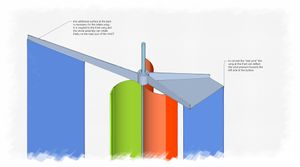
The Enhanced Vertical Axis Wind Turbine idea incorporates an intake manifold at the front which is always facing the direction where the strongest wind is coming from. The main disadvantage of the VAWT against a HAWT is reduced: There is no attacking wind which will work against the natural, clockwise rotation of the VAWT. This may result in an increased overall efficiency.
- + No wind is working 'against' the turbine, contrary to a standard VAWT, where half of the turbine is exposed to wind which flows into the 'wrong' direction
- + The wind speed right at the turbine intake is increased [8]
- + (tbd) less oscillating forces, the wind flow is about unidirectional at the turbine: less vibrations and less wear at the rotating parts, more static and less dynamic thrust at the bearings, less torque ripple and cyclical stress.
- - More material is used for the construction of an EVA wt: two bearings, arms and static wings. However, these additional parts are not difficult to manufacture, as the surfaces are all plane.
Who can help with FEA + fluid dynamics and simulate the wind flow at various EVA wind turbine designs? We want to investigate what wing form the intake should have and at which angle it should be mounted. Also: Does it increase the efficiency if there's another, longer planar surface at the right of the intake parallel to the wind direction (The position where only a short, structural surface is shown in the sketches)
Normal airflow in a VAWT at the maximum torque moment. Note the non-uniform airflow with varying surfaces as the turbine blades advance.[9]
Airflow in the EVA wt design. View from the top.[10]
Example of a simple constructional integration of the EVA wt design with sheet material. ISO-View from the top.[11]
Calculations and Simulations
All calculations are made in the metric system. Corrections and additional approaches are always welcome.
Let's start with the base mount. As the design outlines state we won't start with a turbine greater than 4 m² due to restrictions in Europe pointed out by Detlef Schmitz. A wind surface of 4 m² equals a 2 m diameter rotor with a height of 2 m.
= Density of air = about 1.2 Kg/m³
= Coefficient of drag = 1.0 (cylinder Re > 100)
= Area of turbine = max 4 m²
= Wind speed in m/s
TODO: Leverage should be taken into account here. How to calculate the load at the bearing points?
TODO: Consider serious safety factor for robustness and against oscillations.
Maximum wind speed the turbine has to withstand:
| IEC wind class | I | II | III | IV |
| 50-year-maximum | 50 m/s | 42,5 m/s | 37,5 m/s | 30 m/s |
| average wind speed | 10 m/s | 8,5 m/s | 7,5 m/s | 6 m/s |
Example for a classification in Germany, Berlin: The mean wind speed is classified above IEC class IV with an average value of 2.3 - 3.6 m/s at ground level [12] without any obstacles.
IEC classes are realistic for higher wind zones, industrial wind turbines are usually mounted at >50 m. We are safe with an IEC class IV design. The design should be build for a maximum load of .
Estimating the power output of the VAWT
Power available in the wind:
is the power, which is available in the wind. It is available as kinetic energy due to the moving mass of the air.
= Density of air = about 1.2 Kg/m³
= Area of turbine = max 4 m² at a small scale turbine
= Wind speed in m/s
Power available from the turbine:
This is the estimated mechanical wind power conversion.
while
Fehler beim Parsen (MathML mit SVG- oder PNG-Rückgriff (empfohlen für moderne Browser und Barrierefreiheitswerkzeuge): Ungültige Antwort („Math extension cannot connect to Restbase.“) von Server „https://wikimedia.org/api/rest_v1/“:): {\displaystyle \rho_{simple} = 20% \linebreak \rho_{decent} = 30% \linebreak \rho_{good} = 35% \linebreak \rho_{superbVAWT} = 40% \linebreak \rho_{superbHAWT} = 50% \linebreak \rho_{limit} = 59% \linebreak }
A tuned VAWT may have a best-case efficiency of 40%[13], while a simple drag-based turbine with no optimization nor special aerodynamics may have an efficiency of about 20%.
Other links
- non OS example 1
- http://www.fundamentalform.com/html/involute_wind_turbine.html
- http://www.daswindrad.de/forum/viewtopic.php?f=2&t=21
- http://www.tinytechindia.com/windenergy.htm
- http://www.macarthurmusic.com/johnkwilson/MakingasimpleSavoniuswindturbine.htm A bit more efficient than a standard Savonius
- https://www.youtube.com/playlist?list=PL212B7C0D6057AC28 youtube playlist
Daniel
- http://www.youtube.com/user/danielturbin/videos?sort=dd&view=0 Wind is only one of many nice things he did
- http://www.maskinisten.net/viewtopic.php?t=8655 Forum with pictures and tests explained in Swedish
Sources
- ↑ Tip Speed Ratio
- ↑ work in progress
- ↑ OSE Core Values points 8 and 9 demand a high performance and equal to or higher than industrial efficiency but the efficiency of a highly sophisticated industrial, FEA designed and airflow-simulated, wind tunnel tested model can't be matched by a diy design.
- ↑ http://www.gizmag.com/optimizing-wind-turbine-placement/19217/
- ↑ http://www.reuk.co.uk/Calculation-of-Wind-Power.htm
- ↑ https://en.wikipedia.org/wiki/Tip-speed_ratio
- ↑ http://etemu.com/p/evawt/ETEMUcom_EVAwt6_iso.jpg
- ↑ The deflection at the front adds up two "surfaces" of wind. However, the resulting wind speed won't change drastically.
- ↑ http://etemu.com/p/evawt/ETEMUcom_EVAwt7_top_detailed_diagramm.jpg
- ↑ http://etemu.com/p/evawt/ETEMUcom_EVAwt8_intake.jpg
- ↑ http://etemu.com/p/evawt/ETEMUcom_EVAwt8_intake_top_iso.jpg
- ↑ equals a mast height of 10 m or below
- ↑ Can the EVAwt design yield more? Tbd!
